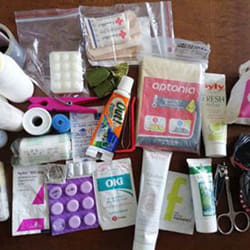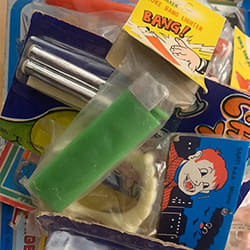
The main beach on the island from the docks
There’s a boat for the Berlengas that leaves from Peniche, which is just under an hour’s drive from our house. You can also hire a private boat to take you there, but the regular ferry takes about forty minutes each way and departs twice a day, once in the morning and once around noon.
The seas are typically rough in the area, so the boat rocks pretty violently, while the waves crash against it with rough and frightening sounds. It’s almost as if the sea is showing off its power. Just when you’ve reached the peak of a wave, you come crashing down with a bang on the other side. If you look behind you, you can see the wave passing behind the ship, rising higher than the stern.
The best thing to do is get to the Peniche docks early so that even if line is already long, you can still get an outside seat. The seats inside the cabin are more spacious—which is nice—but it really takes courage to endure forty minutes of the waves relentlessly slamming the hull. They hand you a black plastic bag before you go inside. I didn’t understand why at first, but after about fifteen minutes of jostling around, its purpose was obvious. As was the purpose of the garbage cans placed by all the bench seats.
The boat ride is rough, but I love the Berlengas so much that I still start itching to go whenever summer comes around. This year we were able to go while my friend from New York was in town for a visit.
The weather was clear and the waves were incredibly calm that day, but it still took an hour to get there. We quickly crossed the coast to hike out to the fort, which is one of my favorite spots.
I usually start at the row of little homes belonging to the fishermen (who are the only ones allowed to live on the island), but this time we left the docks and went along the beach before starting our climb. With every step along this rocky stretch, you see the lizards darting around and the flocks of seagulls circling in the sky.

The white buildings in the background are a fishing camp called the Bairro dos Pescadores.
There are vacation rentals on the island, but for the most part nobody is allowed to live there.
The Berlengas archipelago is located in an area where the Mediterranean and Atlantic climates meet, creating a unique ecosystem. The islands have been protected ever since King Alfonso V wrote a letter saying nobody went hunting there in 1465—the first-ever such designation in Portugal. They have been an official nature preserve for more than thirty years, and were declared a UNESCO biosphere reserve in 2011.
One of the unique birds in the Berlengas is the airo. I referred to them as “seagulls” above , but they aren’t just up in the sky—they’re everywhere. Everywhere! Lizards are everywhere too of course, but they don’t make noise and they’re quite small, so it’s the airo that you really notice.
After walking for about fifteen minutes, the fort comes into view below the cliffs. It’s a slippery downhill trek between here and there, but the destination is so worth it that you completely forget the rough sea voyage it took to get there, the uphill walk from the docks, and even trudging through the dry landscape eyeing the imposing airo on all sides.
Here’s the scene. ↓

That’s the fort in the distance. Once you get down the steps, you follow the bridge to get to it.
The first time I came here, it reminded me so much of the Ghibli Studios film Laputa: Castle in the Sky that I let out my breath in amazement. The bridge from the rocks to the fort in perfect harmony with the beauty of the surrounding sea is like a picture in my mind. Total perfection.
The water was shallow for a good way out that day, so we crossed the rocks that typically lie underwater to reach a barely-accessible beach. We took care not to step on the sea cucumbers sitting between the rocks like crude oil, carefully placing our feet until the water got deep and we started trying to jump. There were big fish, little three-centimeter fish—even tiny fish smaller than the end of your thumb. Maybe it’s because they’re all protected on this nature reserve, but they didn’t seem to mind us being there one bit. They would swim towards us so lazily that it seemed like we could catch them with our hands.

We headed out to the pebbly pink beach on the left
Portuguese waters are chilly, so it’s usually too cold for me to swim—but here in the Berlengas I’m like a mermaid, always in the water. The ocean that usually stings me somehow seems to have a magic charm.

You can also swim under the bridge to the fort
The tide gradually came in, and before we knew it the rocks that we had walked on to get there had disappeared. We started walking our return path until the water was up to our waists, and then followed the same route we had used to get there back to the docks.
The water was calmer than I’d ever seen it on the way back, stretching out to a flat horizon. There wasn’t any danger, so the crew let us sit up on the bow. The wind cutting across the bow hit my face before anyone else’s as we returned to Peniche.
We might even be able to go again before summer is over. For me, the Berlengas are like a secret garden—a special treat created just for me. Part of me wants to share their beauty with the world, but another wants to keep them all to myself.
Next time I go, I think I’ll try to find another secret spot.




























































